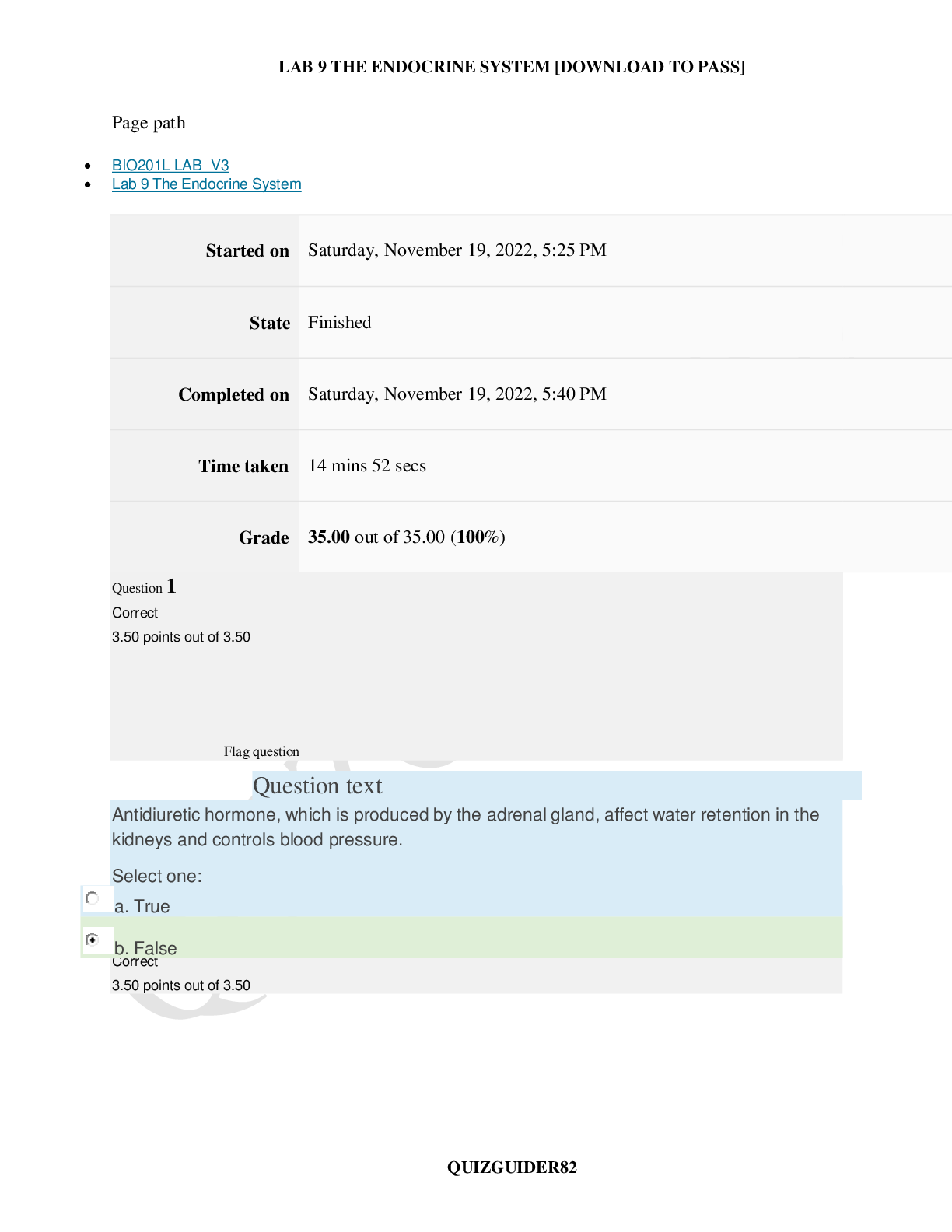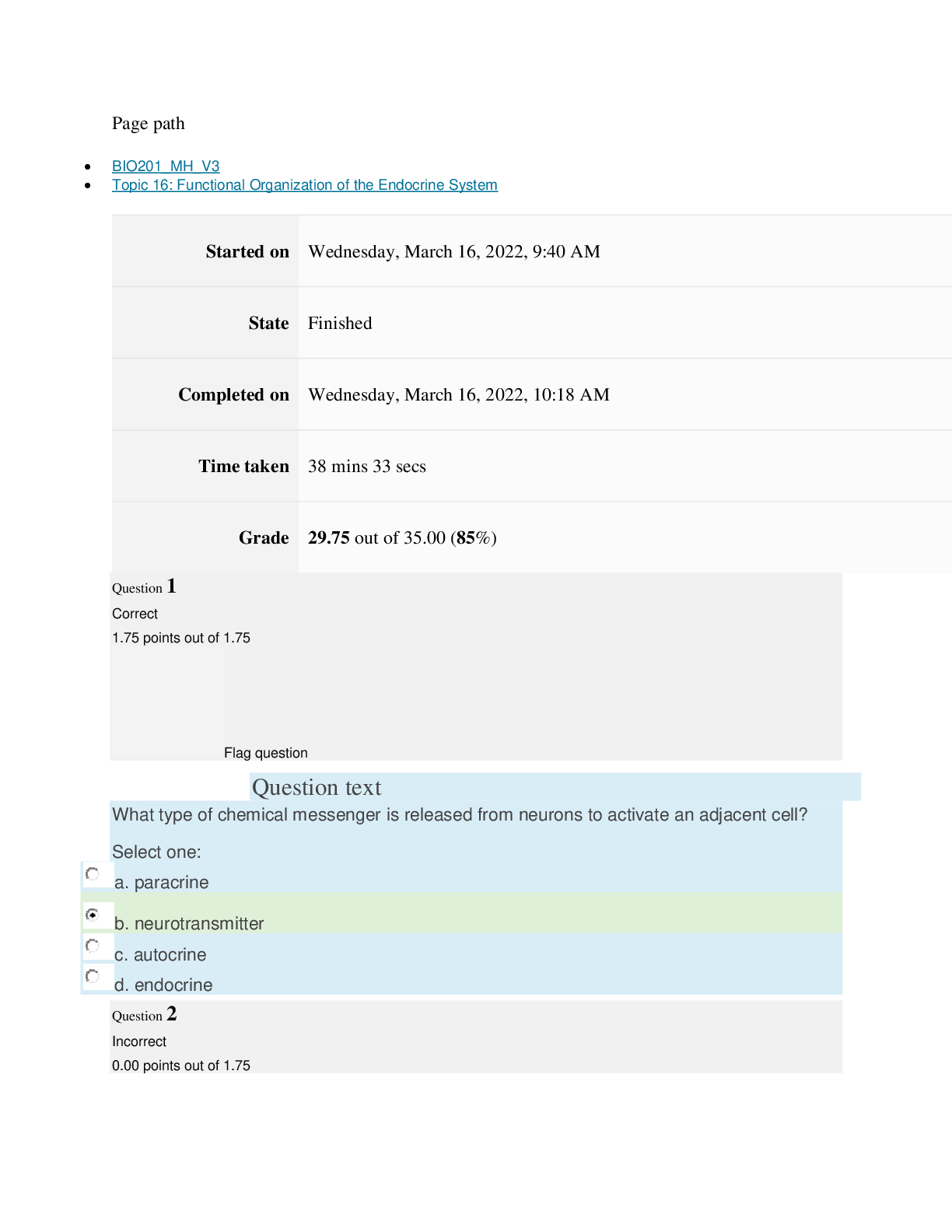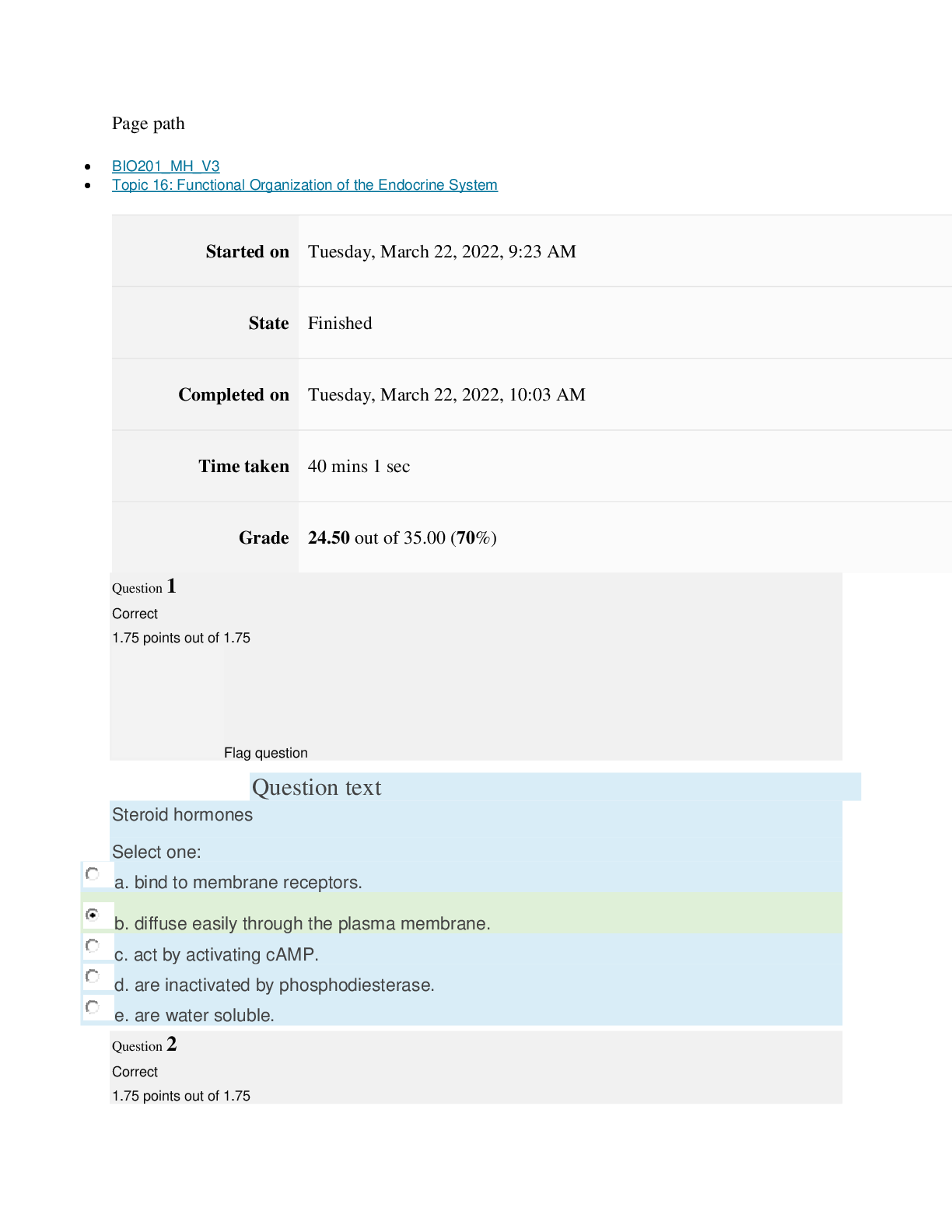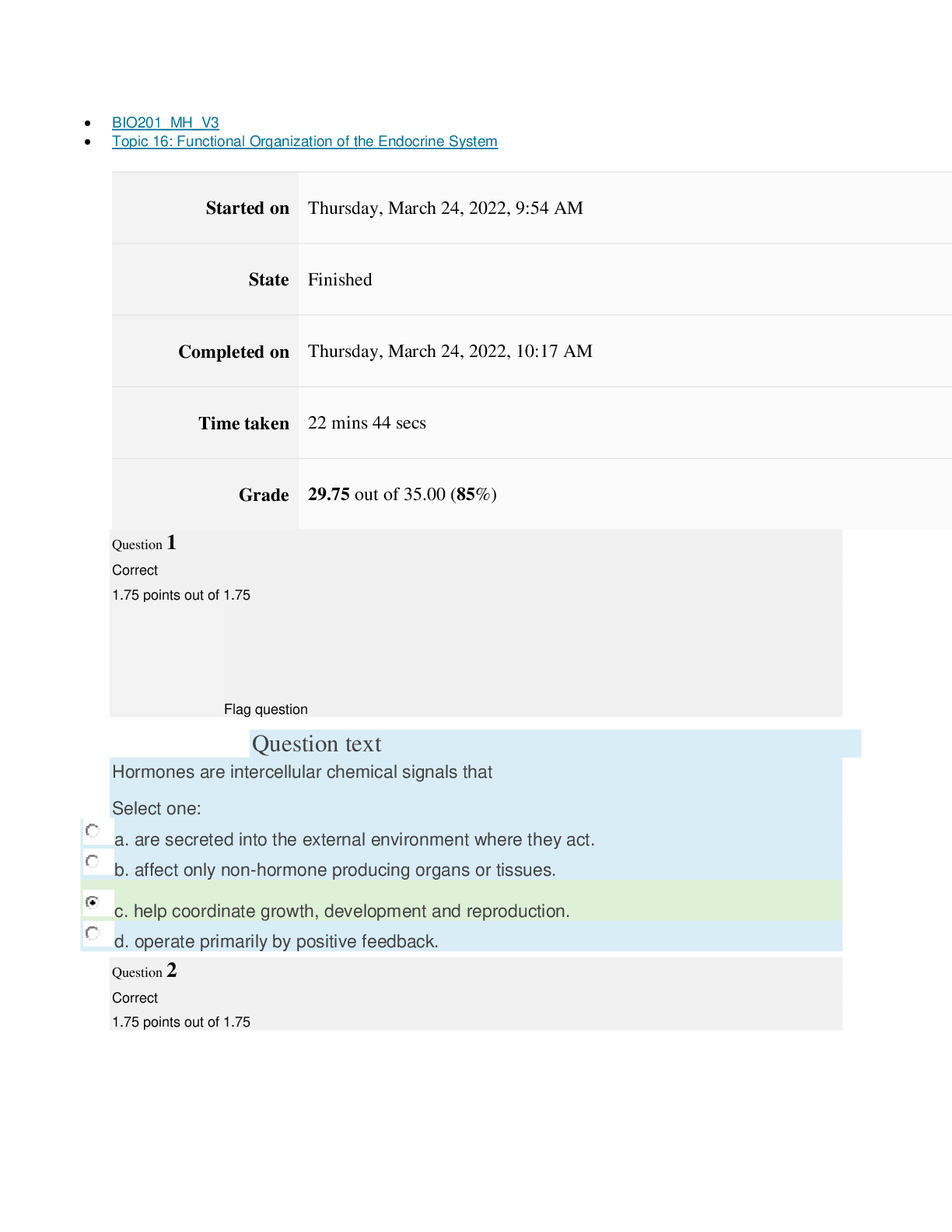*NURSING > QUESTIONS & ANSWERS > TEAS TEST 101 Chapter 16 The Endocrine System Worksheet _ Multiple Questions_Matching & T/F Answers) (All)
TEAS TEST 101 Chapter 16 The Endocrine System Worksheet _ Multiple Questions_Matching & T/F Answers) Summer 2020.
Document Content and Description Below
TEAS TEST 101 Chapter 16 The Endocrine System Worksheet _ & Multiple Questions & Answers) Human Anatomy & Physiology, 10e (Marieb) Chapter 16 The Endocrine System 16.1 Matching Questions ... Figure 16.1 Using Figure 16.1, match the following: 1) Produces the hormones that promote the development of the female secondary sexual characteristics at puberty. 2) Storehouse for the hormones produced by the hypothalamus of the brain. 3) Produces the hormones that direct the production of the secondary male sex characteristics. 4) Produce hormones involved in electrolyte balance and the stress response. 5) Produces hormones and is considered a neuroendocrine organ. Figure 16.2 Using Figure 16.2, match the following anterior pituitary hormones with their targets: 6) Growth hormone. 7) Follicle stimulating hormone. 8) Prolactin. 9) Adrenocorticotropic hormone. Corticotropin-releasing CRH 10) Thyroid stimulating hormone. Thryotropin releasing TRH Match the following: A) Addison's disease B) Diabetes mellitus C) Graves' disease D) Acromegaly E) Pituitary dwarfism 11) An autoimmune problem involving the thyroid gland. 12) Hyposecretion of growth hormone. 13) Hyposecretion of the pancreas. 14) Hyposecretion of the adrenal cortex. 15) Hypersecretion of growth hormone. Match the following: A) Myxedema B) Cushing's disease (Acromegaly) C) Gigantism D) Cretinism 16) Hyposecretion of the thyroid in adults. 17) Hypersecretion of the adrenal cortex. 18) Hypersecretion of growth hormone. 19) Hyposecretion of the thyroid in infants. Match the following: A) Thyroid gland B) Pancreas C) Pituitary gland (hypophysis) D) Adrenal medulla E) Parathyroid glands 20) The size and shape of a pea; produces hormones that stimulate other endocrine glands. 21) Is part of the sympathetic (fight or flight) nervous system. 22) Produces hormones that regulate glucose levels in the body. 23) Primary regulators of blood calcium levels. 24) Produces the body's major metabolic hormones. Figure 16.3 Using Figure 16.3, match the following: 25) Mainly produces glucocorticoids. 26) Produces epinephrine. 27) Produces aldosterone. 28) Excess hormone levels from this region result in Cushing's syndrome. 29) Hormones mimic sympathetic nervous system neurotransmitters. 30) Mainly produces small amounts of gonadocorticoids. Match the following: A) Neural stimulus B) Hormonal stimulus C) Humoral stimulus 31) Testosterone production. 32) Epinephrine production. 33) Aldosterone production. 34) Parathyroid hormone production. 16.2 True/False Questions 1) The pineal gland is used as a brain orientation landmark for brain X rays. 2) Calcitonin is the main regulator of blood calcium levels. (The antagonistic hormones that regulate the blood calcium level are calcitonin parathormone) 3) The hormone that raises blood sugar levels is insulin. False 4) Addison's disease is usually due to an insufficient output of glucocorticoids only. 5) Both "turn on" factors (hormonal, humoral, and neural stimuli) and "turn off" factors (feedback inhibition and others) may be modulated by the activity of the nervous system. True 6) ACTH stimulates the adrenal cortex to release corticosteroid hormones. 7) LH is also referred to as a gonadotropin. 8) Examples of adrenal gland short-term stress responses include immune system suppression and retention of salt and water by the kidneys. 8) In aged individuals, chronic stress may increase blood levels of cortisol and possibly contribute to memory deterioration 9) Oxytocin is a strong stimulant of uterine contractions. True 10) Enteroendocrine cells of the GI tract produce some hormones that are chemically identical to neurotransmitters. 10)Follicle cells of the thyroid gland produce thyroglobulin, while follicle cells of the parathyroid produce calcitonin. 11) Type 2 diabetes mellitus may reflect declining receptor sensitivity to insulin rather than decreased insulin production. 12) The prime metabolic effect of cortisol is gluconeogenesis. 13) The beta cells in the pancreatic islets produce insulin. 14) Most type 2 diabetics do NOT produce insulin. 15) Aldosterone is the most potent mineralocorticoid produced by the adrenal glands but the least abundant. 16) Atrial natriuretic peptide is a hormone that controls blood pressure in part by increasing the urinary excretion of sodium. 17) Hypersecretion of catecholamines (epinephrine and norepinephrine) can result in hypertension. 17) The thyroid gland is a large gland that controls metabolic functions throughout the life of an individual 17) All of the following hormones are secreted by the adenohypophysis: ACTH, FSH, and LH. 18) Thyroid hormone production requires the presence of both iodine and calcium. False 19) Many hormones synthesized in the gastrointestinal tract are chemically identical to brain neurotransmitters. 20) Oxytocin and ADH are produced in the posterior pituitary. 21) Iodine is an essential element required for the synthesis of thyroxine. 22) The endocrine gland that is probably malfunctioning if a person has a high metabolic rate is the parathyroid. 23) Growth hormone solely exerts its influence by targeting other endocrine glands to produce hormones. 24) Glucocorticoids are steroid hormones that usually enhance the immune responses when an individual is suffering from severe stress. 25) Direct gene activation involves a second-messenger system. False 26) All amino acid based hormones are lipid soluble and can cross the plasma membrane. 26) All peptide hormone synthesis requires gene activation that produces mRNA 27) All anterior pituitary (adenohypophyseal) hormones EXCEPT growth hormone affect their target cells via a cyclic AMP second-messenger system. 16.3 Multiple Choice Questions 1) Gluconeogenesis, the formation of glucose from fats and proteins, is due to the action of ________. A) aldosterone B) insulin C) secretin D) cortisol 2) Normal development of the immune response is due in part to hormones produced by the ________. A) adrenal medulla B) pancreas C) thyroid gland D) thymus gland 3) Virtually all amino acid-based hormones exert their signaling effects through intracellular ________. A) calcium B) deactivating ions C) nucleotides D) second messengers 4) Which of the following is NOT a category of endocrine gland stimulus? A) enzymatic B) humoral C) neural D) hormonal 5) Chemical substances secreted by cells into the extracellular fluids that travel through the blood and regulate the metabolic function of other cells in the body are called ________. A) enzymes B) antibodies C) proteins D) hormones 6) The hypothalamic-hypophyseal tract ________. A) connects the hypophysis to the pituitary gland B) runs through the infundibulum C) conducts aldosterone to the hypophysis D) is the site of prolactin synthesis 7) Which of the following is NOT a cardinal sign of diabetes mellitus? A) polyuria B) polydipsia C) polyphagia D) polycythemia (All of these are signs) 8) Which of the following can act on receptors inside the target cell that directly activate specific genes? A) growth hormone B) testosterone C) calcitonin D) melatonin 9) Oxytocin ________. A) release is an example of a positive feedback control mechanism B) is an anterior pituitary secretion C) exerts its most important effects during menstruation D) controls milk production 10) Antidiuretic hormone (ADH) ________. A) increases urine production B) promotes dehydration C) is produced by the anterior pituitary D) secretion is inhibited by alcohol 11) Which of the following is NOT a type of hormone interaction? A) permissiveness B) synergism C) antagonism D) feedback 12) Which of the following is NOT a change typically produced by a hormonal stimulus? A) activates or deactivates enzymes B) stimulates production of an action potential C) alters plasma membrane permeability D) induces secretory activity 13) Which of the following hormones suppresses appetite and increases energy expenditure? A) gastrin B) secretin C) leptin D) aldosterone 14) Which of the following is NOT a change that may be caused by hormonal stimulus? A) a change in membrane potential B) stimulation of mitosis C) an increase in enzyme synthesis D) direct control of the nervous system 15) The ability of a specific tissue or organ to respond to the presence of a hormone is dependent on ________. A) the location of the tissue or organ with respect to the circulatory path B) the membrane potential of the cells of the target organ C) the presence of the appropriate receptors on the cells of the target tissue or organ D) nothing—all hormones of the human body are able to stimulate any and all cell types because hormones are powerful and nonspecific 16) Several hormones are synthesized in the hypothalamus and transported to the anterior pituitary gland. The mechanism of transportation from hypothalamus to anterior pituitary gland is through the ________. A) hepatic portal system B) general circulatory system C) hypophyseal portal system D) feedback loop 17) The posterior lobe of the pituitary gland is NOT a true endocrine gland because ________. A) it is strictly a part of the neural system and has little or nothing to do with hormonal release B) embryonically it was an endocrine tissue, but in the adult human it is no longer functional C) it is unable to function as an endocrine tissue because it is actually part of the neural system due to its location D) it is only a hormone storage area that receives hormones from the hypothalamus for release 18) Steroid hormones exert their action by ________. A) entering the nucleus of a cell and initiating or altering the expression of a gene B) binding cell receptors and initiating cAMP activity C) entering the cell and activating mitochondrial DNA D) activating the hypothalamic release of regulating hormones 19) The second-messenger mechanism of hormone action operates by ________. A) synthesizing more than one hormone at a time B) increasing the basal metabolic rate in the target organ C) altering gene expression in the nuclear DNA D) binding to specific receptors and employing the services of G proteins and cAMP 20) Hormones often cause a cell to elicit multiple responses; this is because ________. A) there are thousands of receptors on the cell membrane B) the receptors bind to several hormones at the same time C) the protein kinases are rapidly metabolized into functional amino acids D) during protein kinase activation, enzymes phosphorylate many other enzymes 21) Cells that respond to peptide hormones usually do so through a sequence of biochemical reactions involving receptor and kinase activation. In order for cells to respond, it is necessary for first and second messengers to communicate. This is possible because ________. A) peptide hormones are converted by cell membranes enzymes into second messengers B) hormones alter cellular operations through direct stimulation of a gene C) G protein acts as the link between first and second messengers D) the hormone receptor complex moves into the cytoplasm as a unit 22) Thyroid hormone (a small iodinated amine) enters target cells in a manner similar to ________. A) insulin, because insulin is a small peptide B) steroid hormones, because both diffuse easily into target cells C) growth hormone, because the thyroid works synergistically with thyroid hormone D) glucagon, because the structure of glucagon is similar to that of thyroid hormone 23) Which anterior pituitary hormone does NOT target another endocrine gland? A) adrenocorticotropic hormone (ACTH) B) growth hormone C) follicle-stimulating hormone D) luteinizing hormone 24) One of the least complicated of the endocrine control systems directly responds to changing blood levels of ions and nutrients. Which of the following describes this mechanism? A) carbohydrate oxidation B) catabolic inhibition C) protein synthesis D) humoral stimulation 25) The major targets of growth hormone are ________. A) the blood vessels B) the adrenal glands C) the liver and gall bladder D) bones and skeletal muscles 26) Which of the following is NOT a parathyroid gland mechanism to maintain adequate levels of blood calcium? A) activation of osteoclasts B) increased calcium ion reabsorption by the kidneys C) increased intestinal absorption of calcium ions D) inhibition of calcitonin synthesis 27) Which organ is responsible for synthesizing the hormone atrial natriuretic peptide (ANP)? A) the heart B) the kidney C) the skin D) the spleen 28) Mineralocorticoid is to aldosterone as glucocorticoid is to ________. A) testosterone B) estrogen C) cortisol D) epinephrine 29) Leptin is secreted by ________. A) lymphocytes B) adipose cells C) goblet cells D) fibroblasts 30) The most important mineralocorticoid regulator of electrolyte concentrations in extracellular fluids is ________. A) insulin B) aldosterone C) glucagon D) cortisol 31) Which of the following is NOT a steroid-based hormone? A) estrogen B) aldosterone C) epinephrine D) cortisol 32) The single most important regulator of calcium levels in the blood is ________. A) calcitonin B) parathyroid hormone C) thyroid hormone D) gonadotropic hormones 33) Cellular responses to hormones that initiate second-messenger systems include ________. A) possible activation of several different second-messenger systems B) cyclic AMP phosphodiesterase formation of an active second messenger C) formation of a specific protein kinase that acts on a series of extracellular intermediates D) hormone binding to intracellular receptors 34) Regulating hormones from the hypothalamus ________. A) enter venous circulation and travel to the heart, which pumps the hormone-containing blood to the pituitary B) enter the hepatic portal system, which feeds the pituitary C) travel by arteries to the pituitary D) first enter into the hypophyseal portal system 35) Adrenocorticotropic hormone (ACTH) ________. A) is secreted by the posterior pituitary B) secretion is regulated by a hypothalamic regulatory hormone C) causes the release of hormones from the adrenal medulla D) is not a tropic hormone 36) Aldosterone ________. A) is secreted by the posterior pituitary B) functions to increase sodium reabsorption C) presence increases potassium concentration in the blood D) production is greatly influenced by ACTH 37) Which organ does NOT produce hormones? A) heart B) kidney C) spleen D) skin 38) In circumstances where the body requires prolonged or increased levels of a hormone, the DNA of target cells will specify the synthesis of more receptors on the surface of the cells of the target organ. This is known as ________. A) sensitivity increase B) cellular affinity C) up-regulation D) a stressor reaction 39) Eicosanoids do NOT include ________. A) paracrines B) leukotrienes C) hydrocortisones D) prostaglandins 40) A man has been told that he is NOT synthesizing enough follicle-stimulating hormone (FSH), and for this reason he may be unable to father a child. Choose the correct statement to explain this problem. A) FSH stimulates estrogen secretion by ovarian cells; therefore it is not synthesized by males. B) A hormone made in the anterior pituitary cannot influence fertility. C) FSH stimulates sperm production in the testes. D) The man must be producing progesterone, which inhibits the synthesis of FSH. 41) Thyroxine is a peptide hormone, but its mechanism is different from other peptide hormones. Which of the following statements is true concerning this difference? A) It causes positive feedback. B) It does not require a second messenger to cause a response. C) It is very specific in the cell type it targets. D) It is a stimulant of cellular metabolism and targets all cells. 42) How do glucocorticoids enable the body to deal appropriately with stress? A) by increasing blood glucose, fatty acid, and amino acid levels and enhancing blood pressure B) by decreasing the heart rate, thus decreasing blood pressure C) by stimulating the pancreas to release insulin D) by releasing the neurotransmitters that prepare the body for the stress response 43) What ion is sometimes used as a second messenger of amino acid-based hormones? A) iron B) calcium C) sodium D) chlorine 44) John tells you that cholesterol is bad and should be eliminated from the diet. You explain to him that cholesterol is important. Which of the following hormones are synthesized from cholesterol? A) growth hormone B) testosterone C) oxytocin D) thyroxine 45) Which hormone has only one known effect: to stimulate milk production by the breasts? A) progesterone B) estrogen C) oxytocin D) prolactin 46) Bisphenol-A (BPA) is an endocrine disruptor that can leach out of certain plastics. It disrupts the normal function of the endocrine system my mimicking estrogen. Which of the following explains how persistent small amounts of BPA in the body can have effects? A) up-regulation B) down-regulation C) half-life D) lock-and-key 47) The parathyroid glands respond to which type of stimulus? A) hormonal B) neural C) humoral D) positive 48) Dave has discovered a new lipid-soluble hormone. Which of the following is true regarding this hormone? A) will likely act through a second-messenger system B) receptor will be located on the plasma membrane C) can be stored in secretory vesicles D) will be bound to a transport protein in the blood 49) During an afternoon class, Lisa starts to feel hungry and worries that her blood sugar level may be dropping. Which hormone is helping to prevent a drop in blood sugar level? A) insulin B) glucagon C) aldosterone D) thyroxine 50) Upon landing at the airport in Lagos, Nigeria, Eric feels wide awake even though the local time is 11pm. Which synthetic hormone supplement could he administer to help adjust to the new time zone? A) melatonin B) glucagon C) insulin D) growth hormone 51) At age 85, Lyle's immune system does not respond to vaccines as well as it did when he was younger. The atrophy of which endocrine gland is likely responsible for this? A) thyroid B) anterior pituitary C) adrenal D) thymus 52) Johanna is significantly shorter than normal for her age. Her doctor recommends treatment with a hormone before her growth plates ossify in her long bones. Which hormone is recommended? A) thyroid stimulating hormone B) parathyroid hormone C) growth hormone D) cortisol 53) As a result of stress the anterior pituitary releases ________, which stimulates release of hormones from the adrenal cortex that retain sodium and water, increase blood sugar, and begin breaking down fats. A) thyroid stimulating hormone B) growth hormone C) ACTH D) ADH [Show More]
Last updated: 1 year ago
Preview 1 out of 14 pages
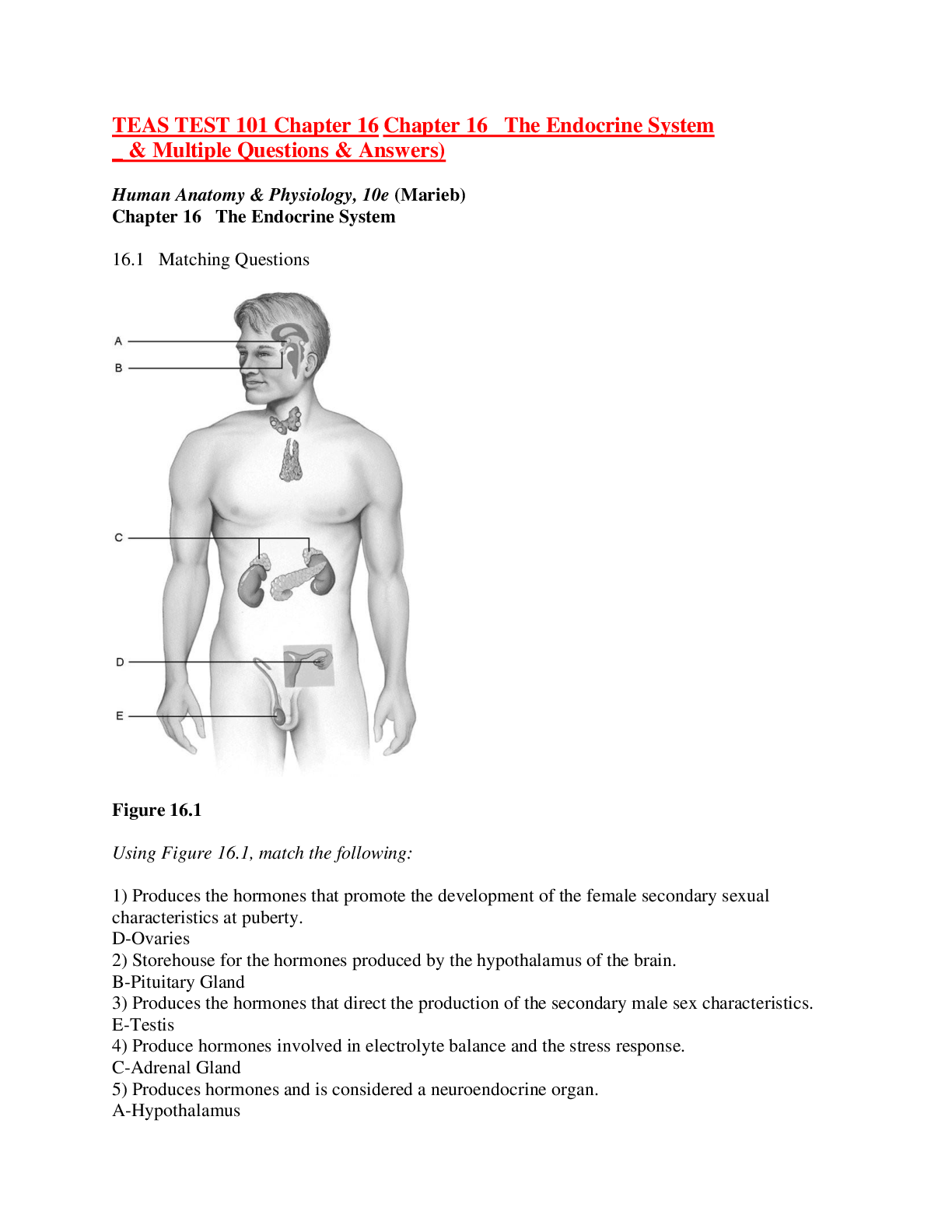
Reviews( 0 )
Document information
Connected school, study & course
About the document
Uploaded On
May 08, 2020
Number of pages
14
Written in
Additional information
This document has been written for:
Uploaded
May 08, 2020
Downloads
0
Views
357

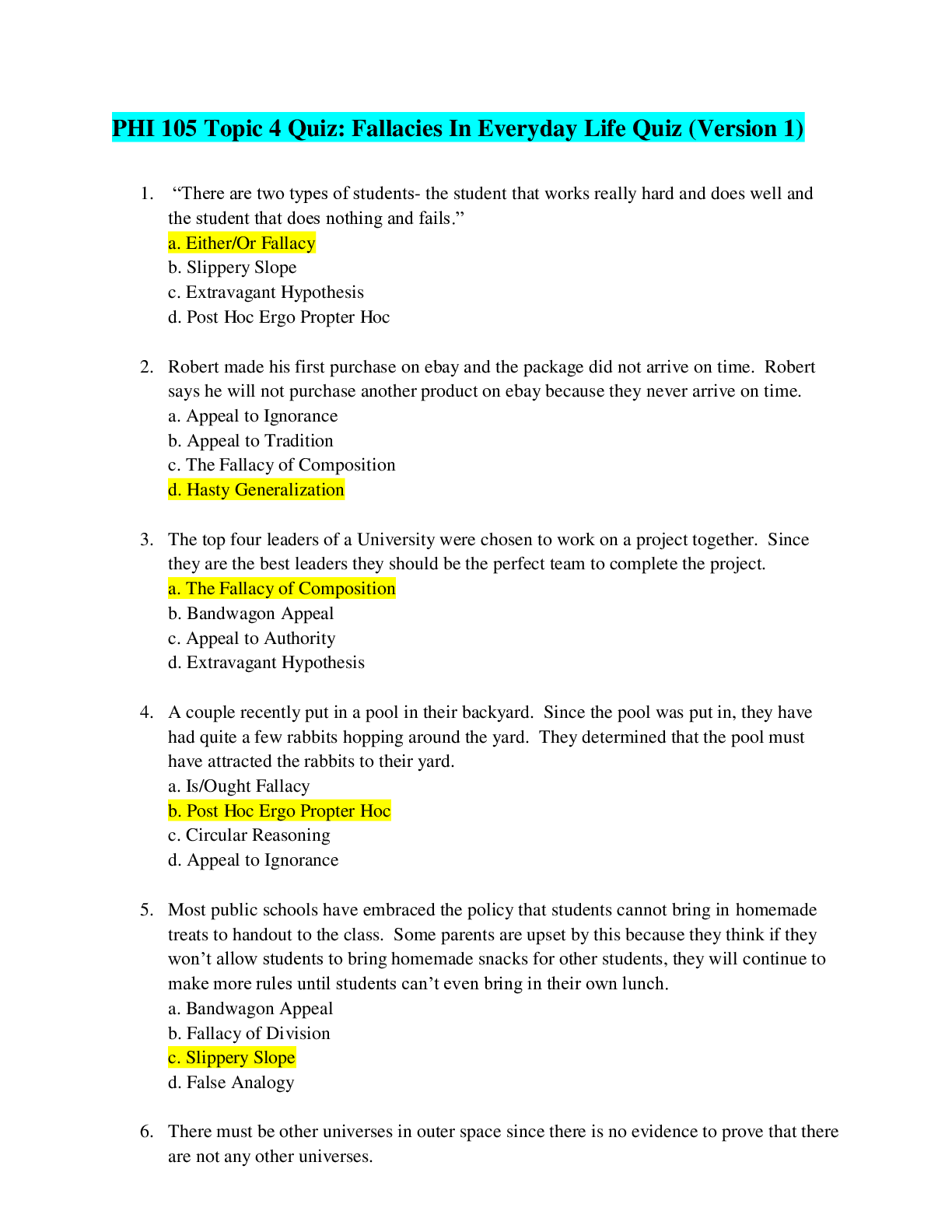


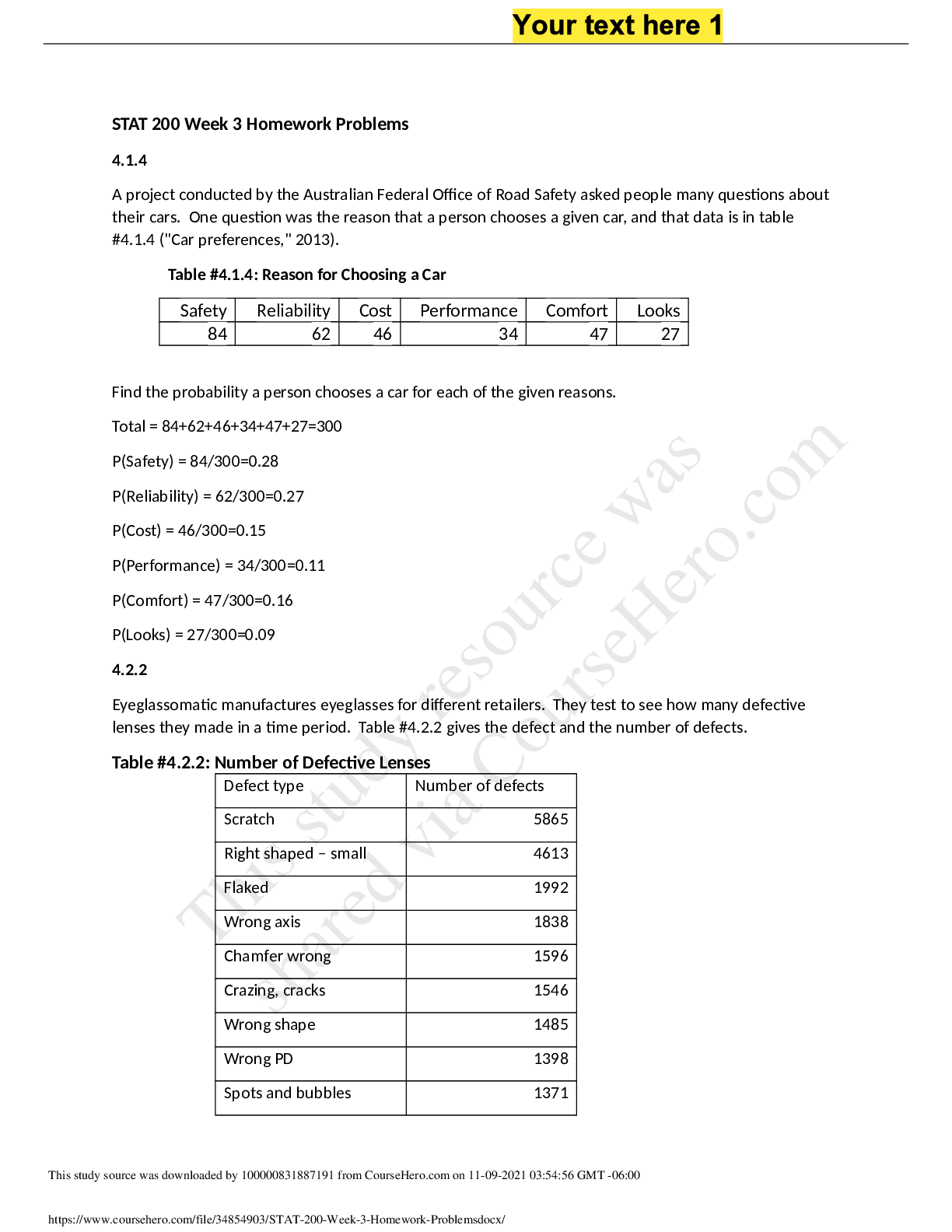
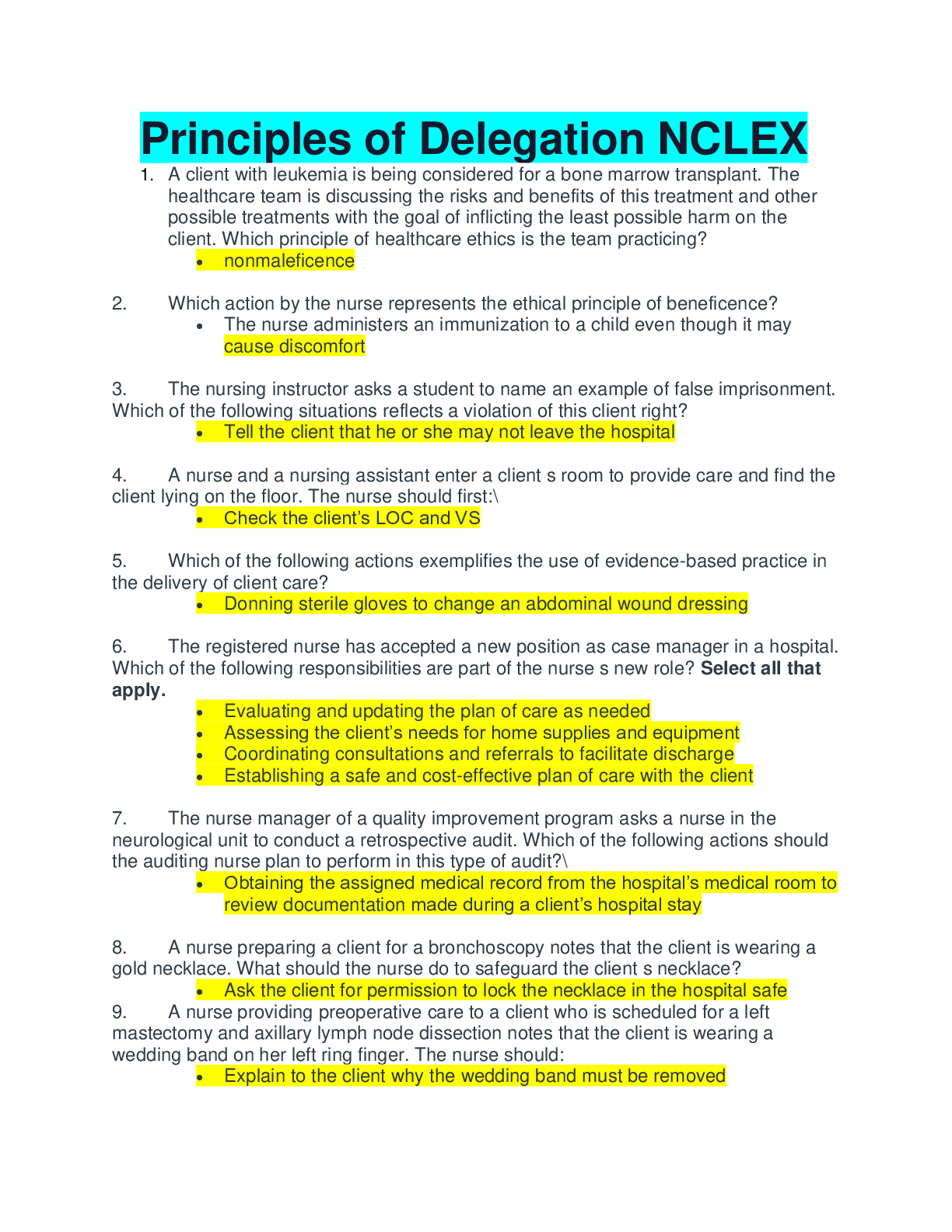
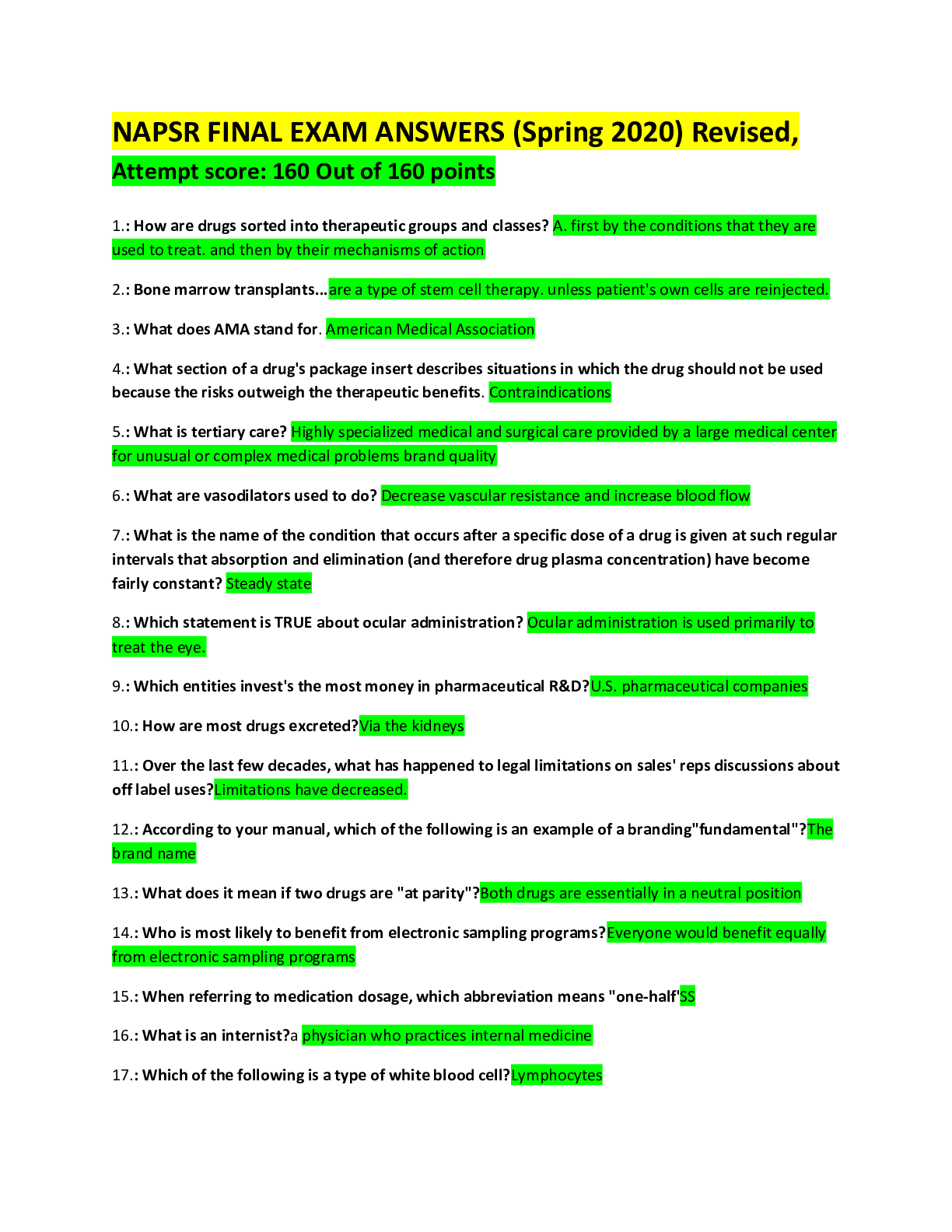
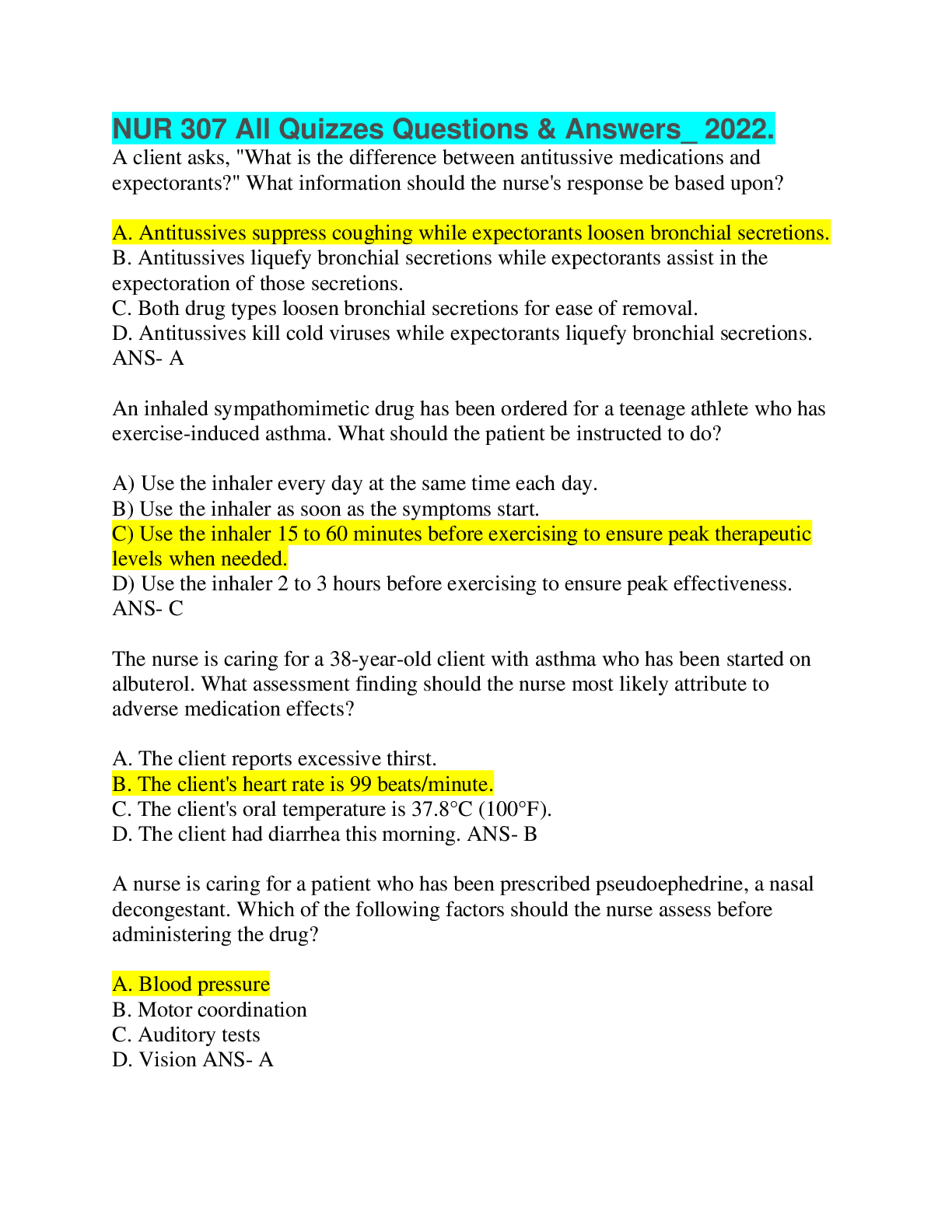
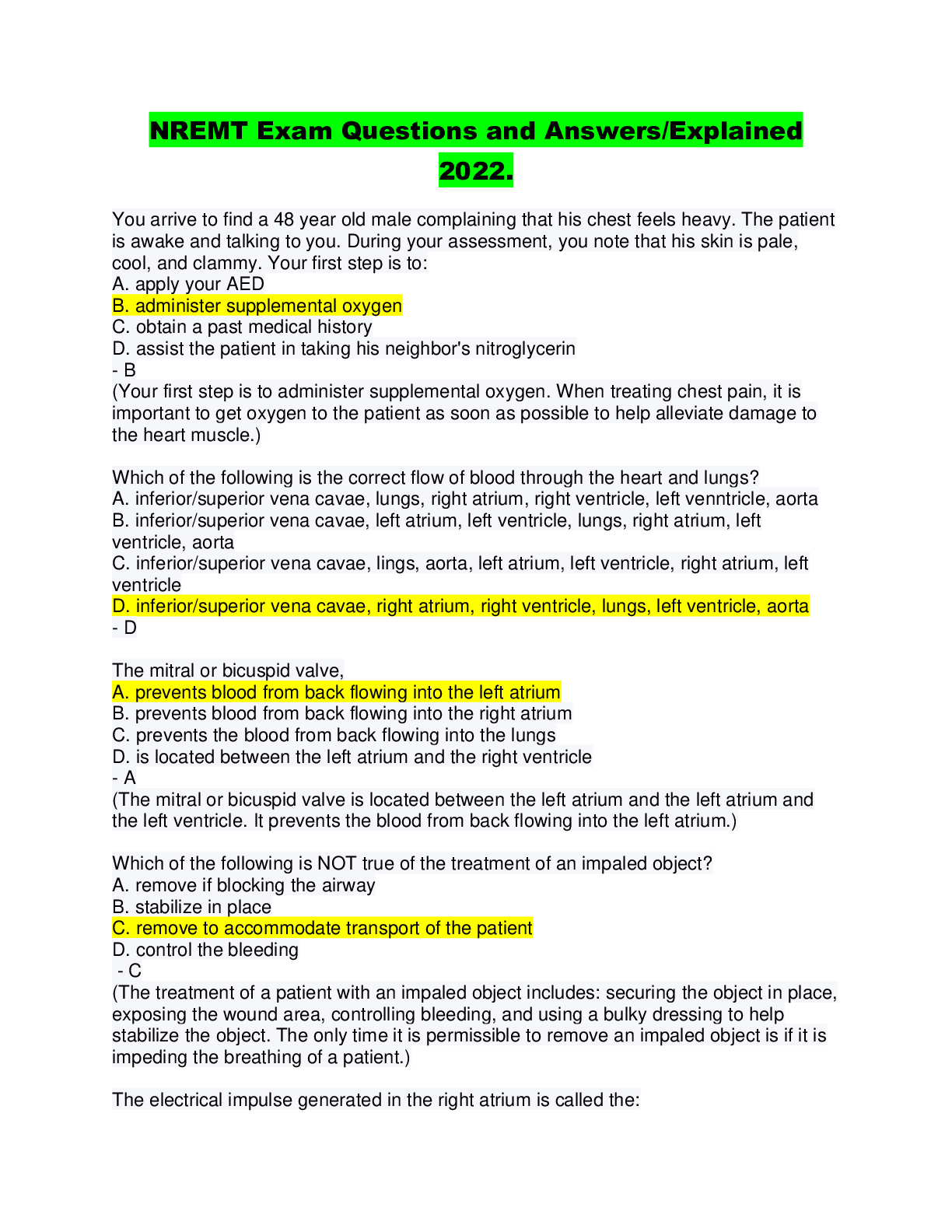

.png)
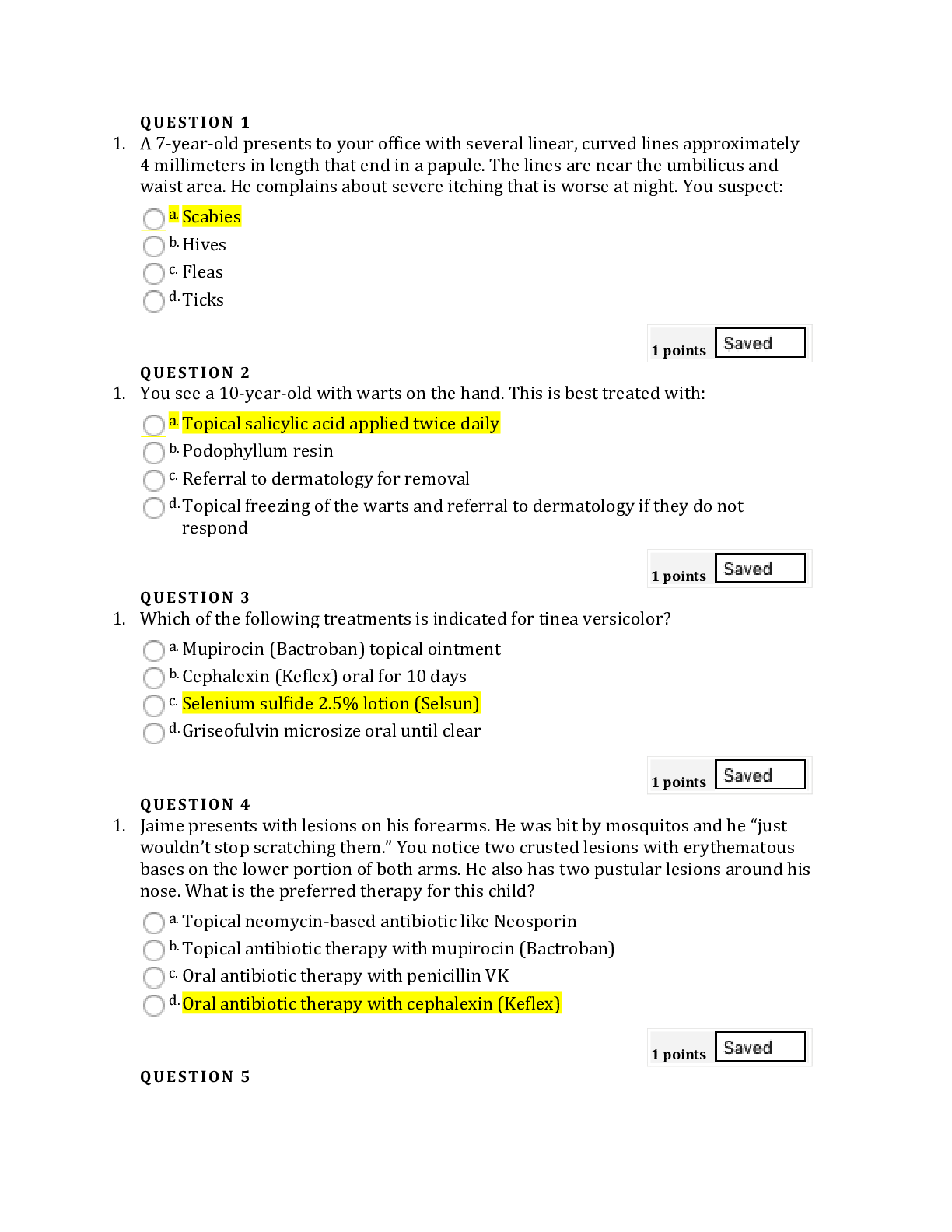
.png)
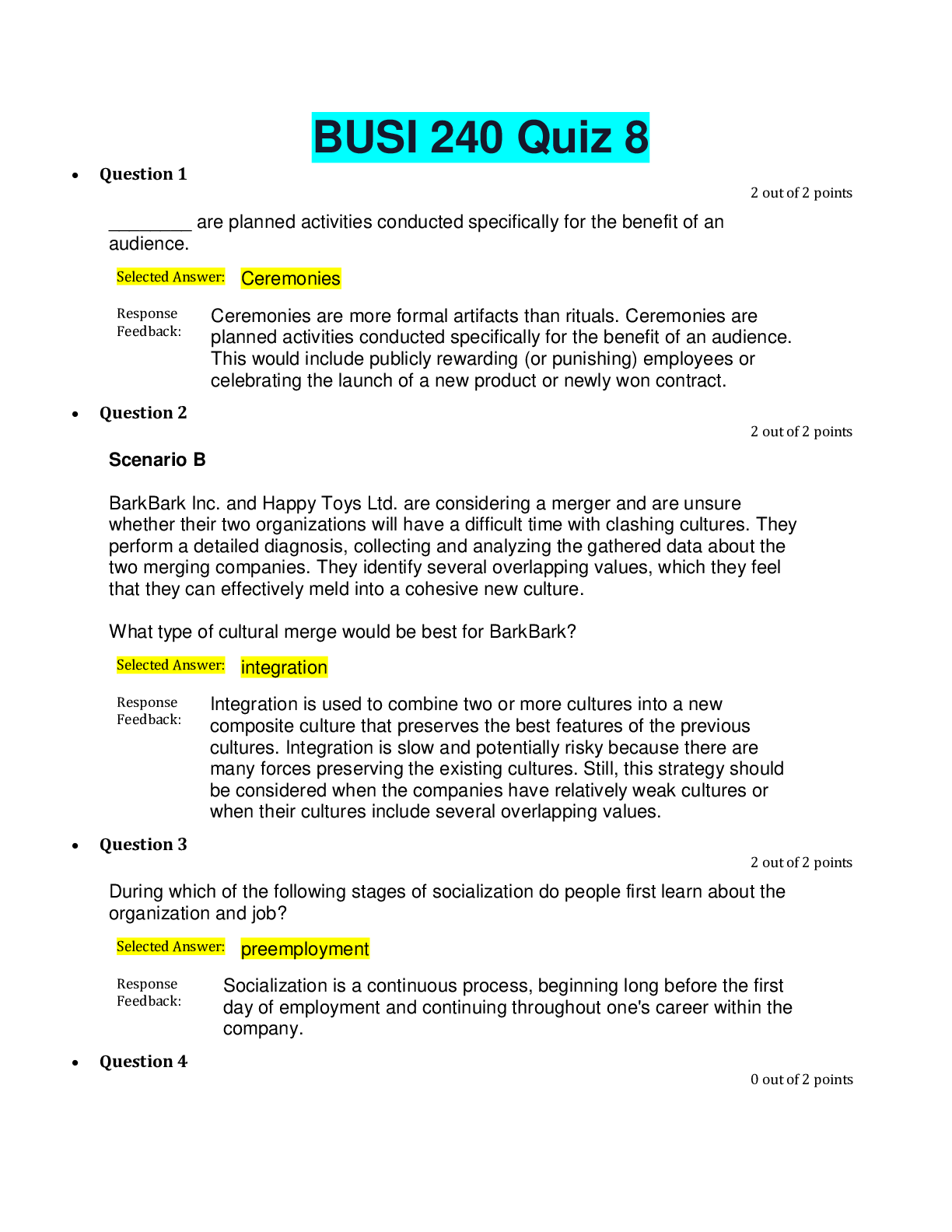
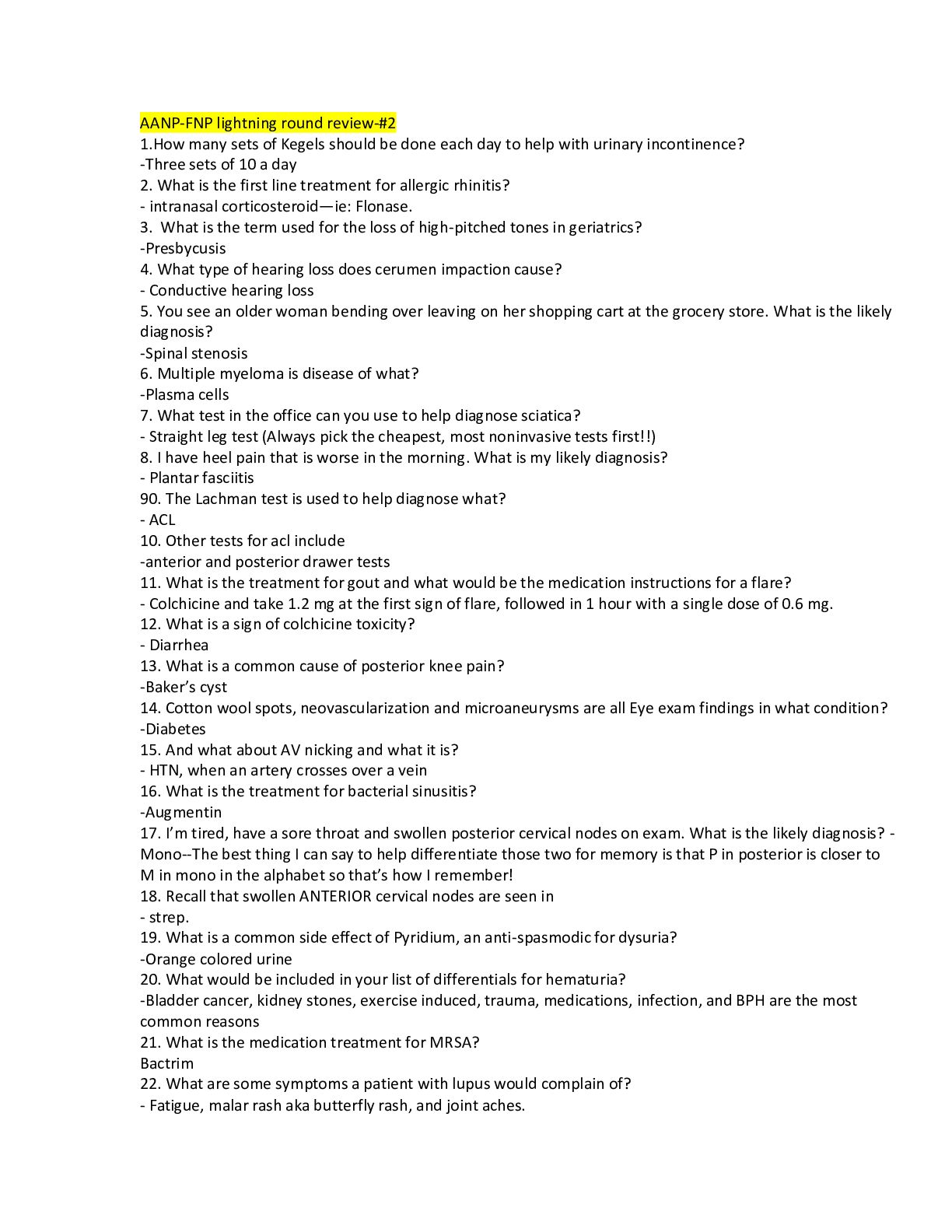
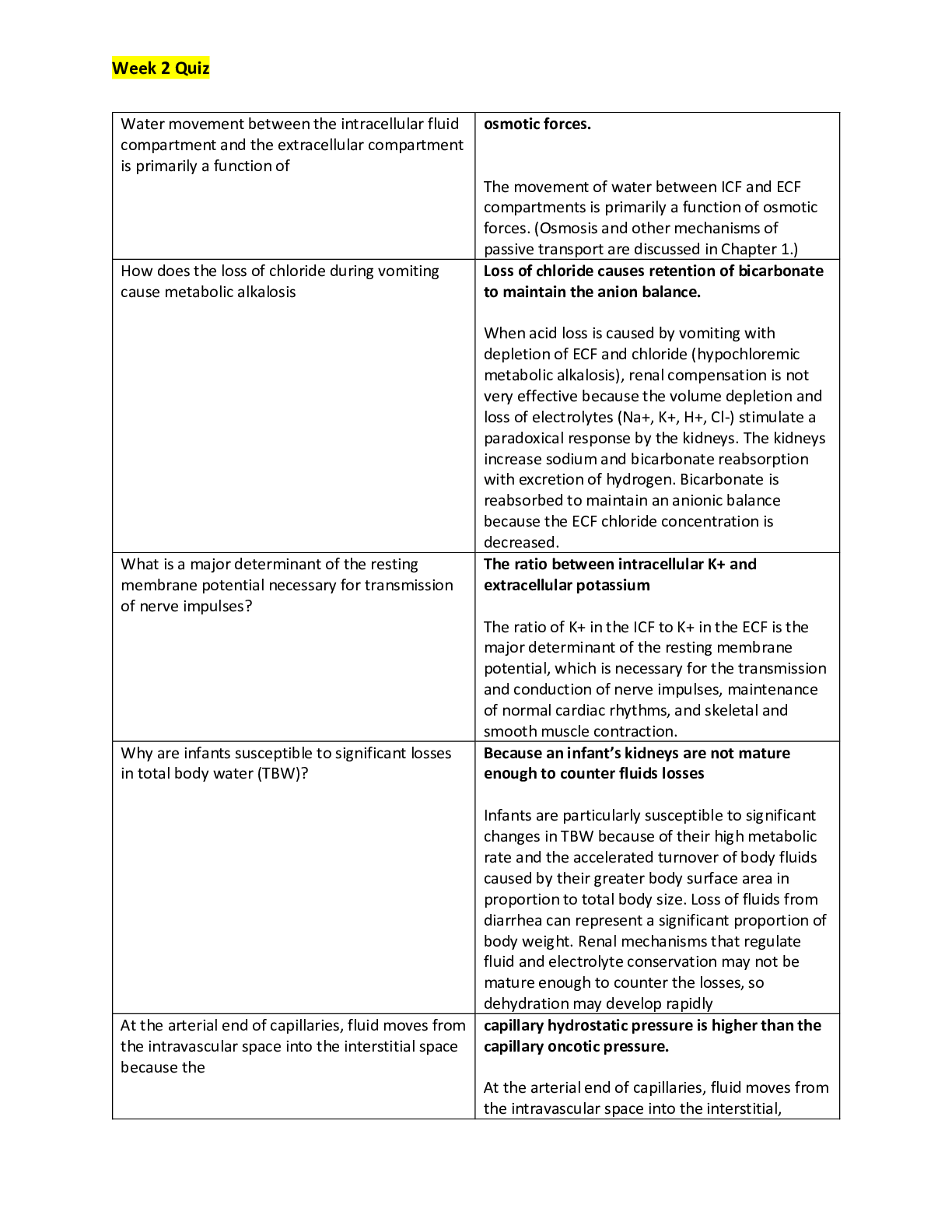
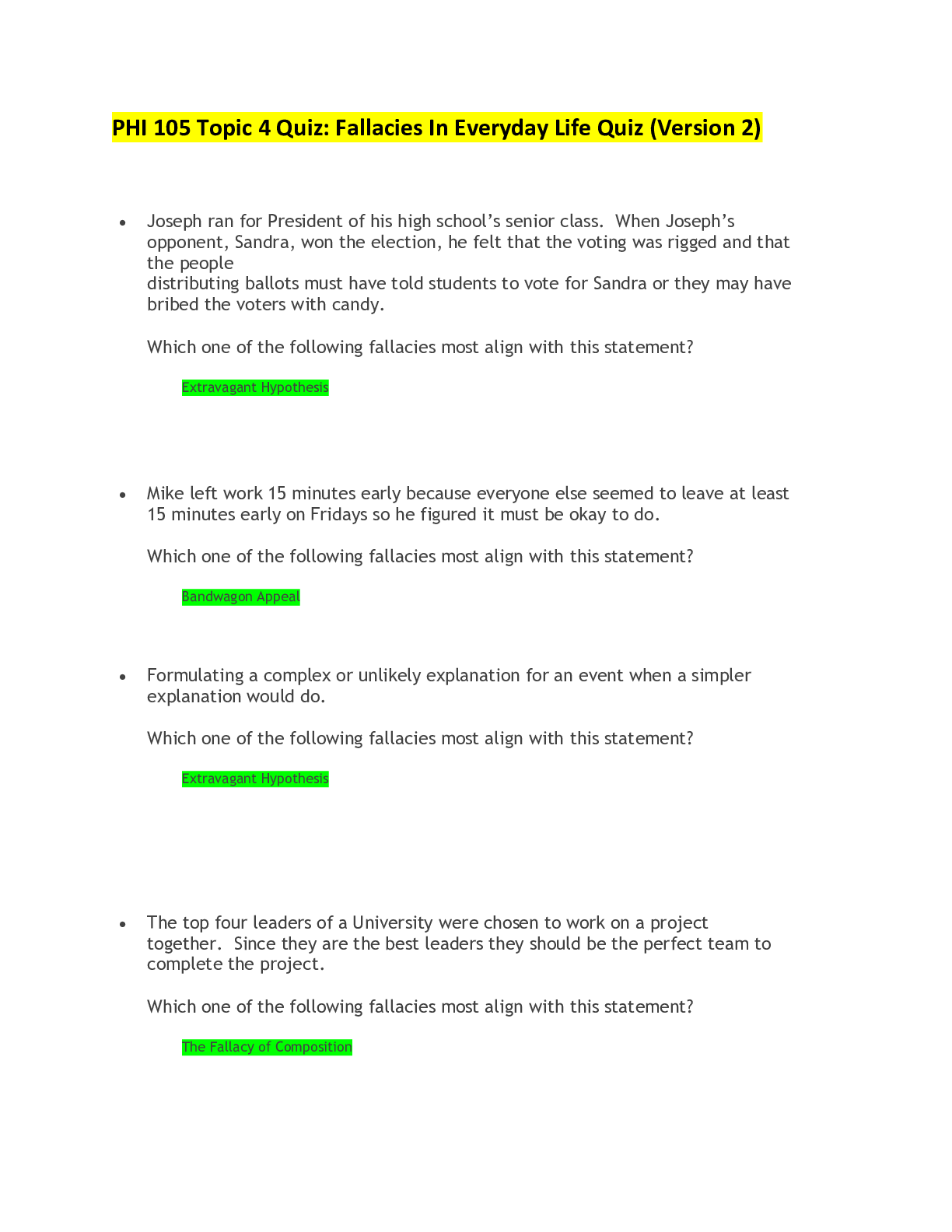
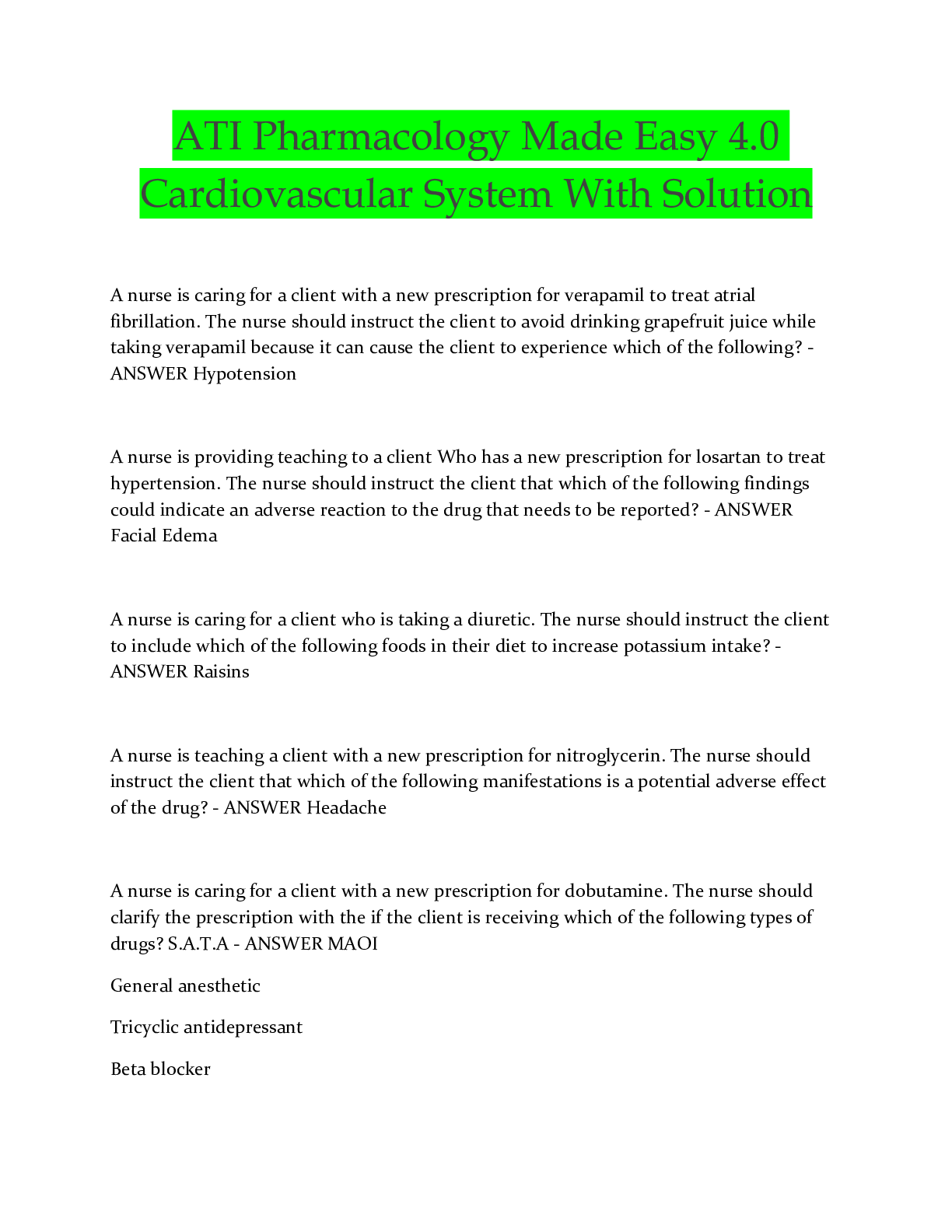
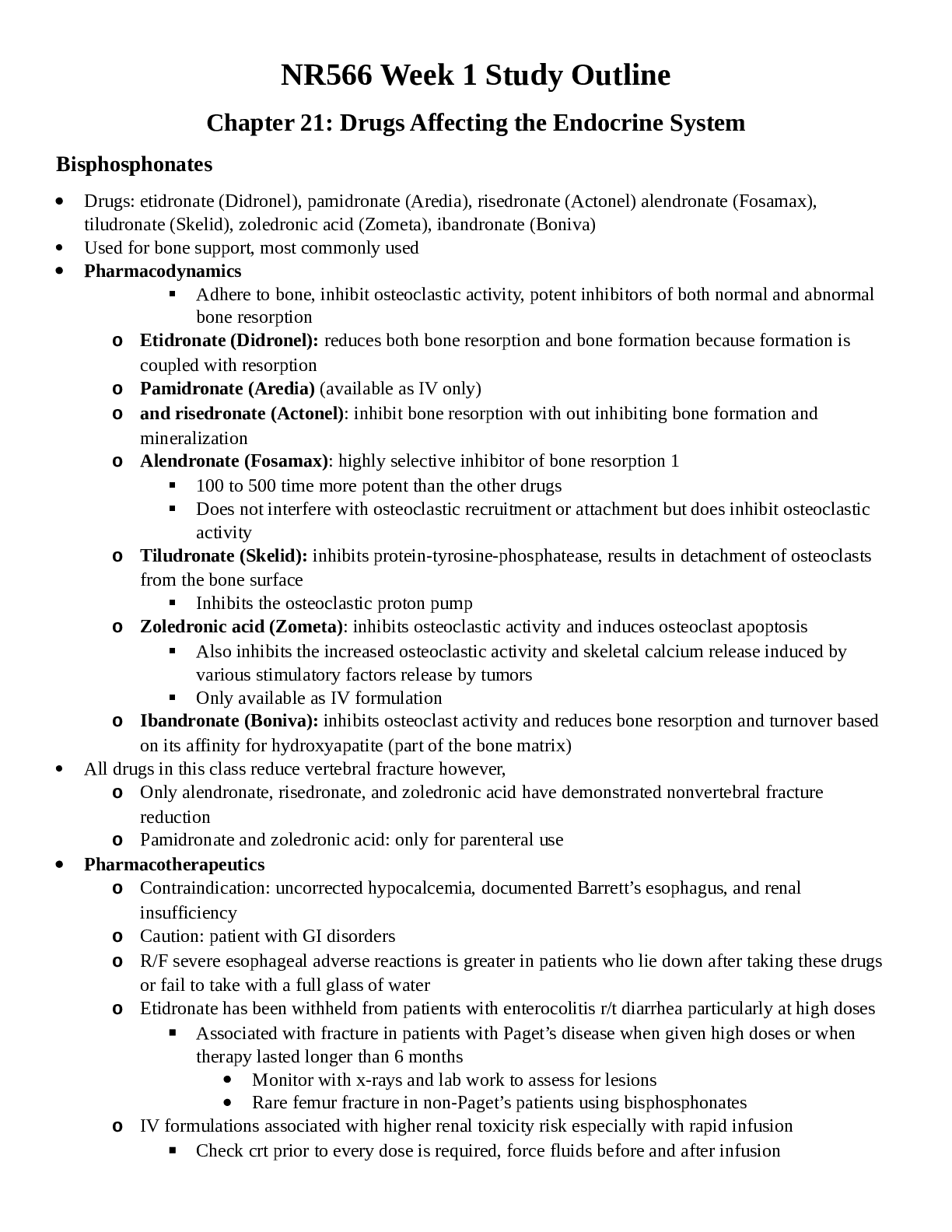
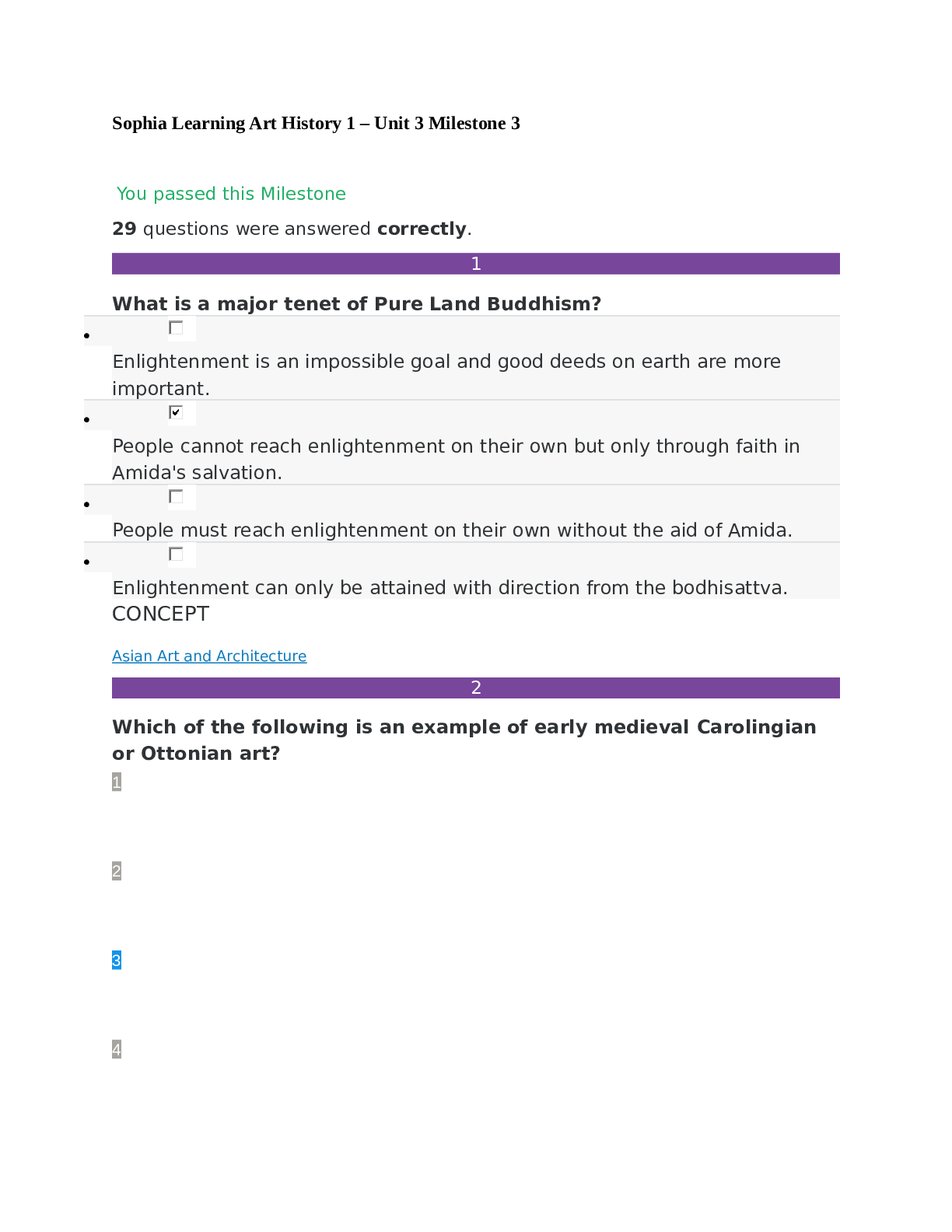
 (2).png)
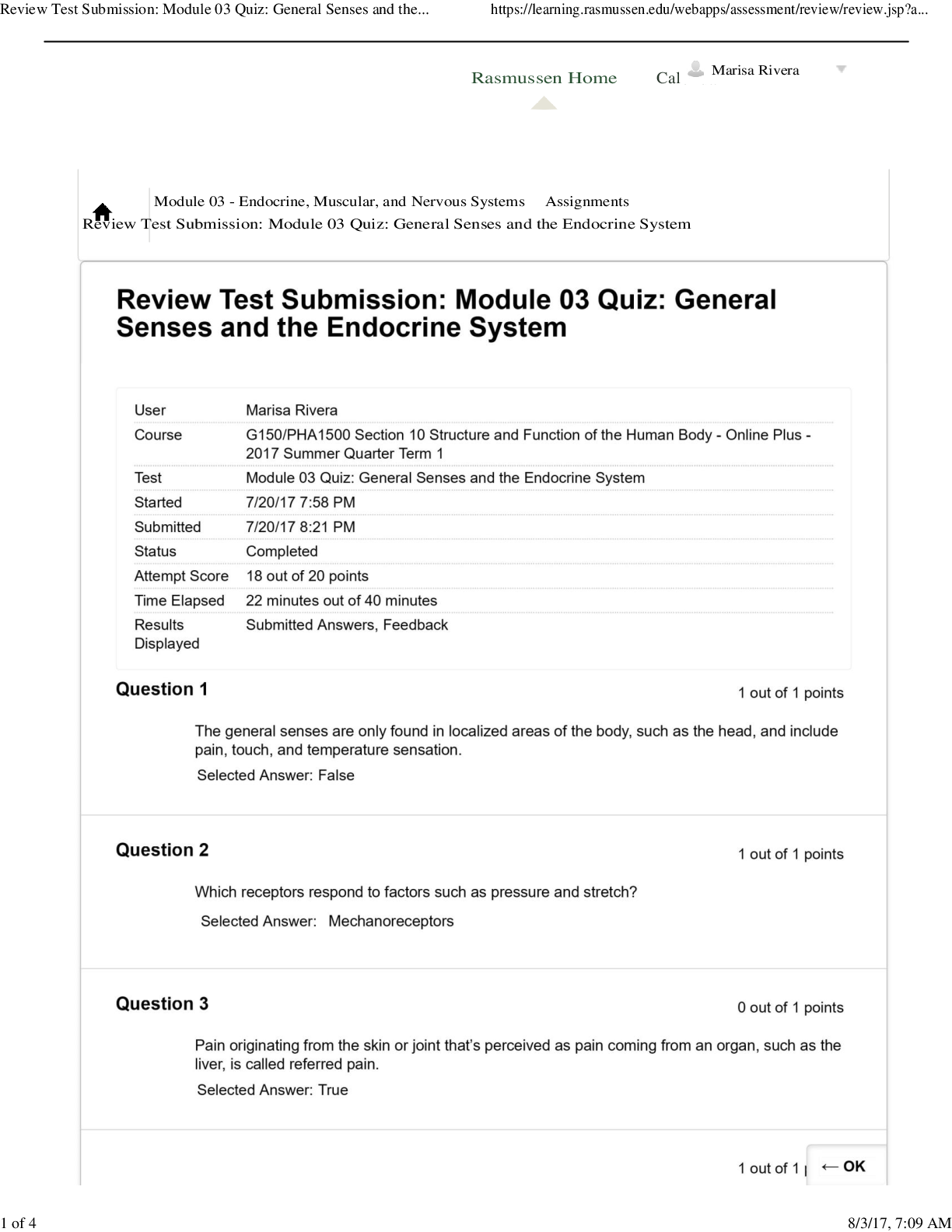
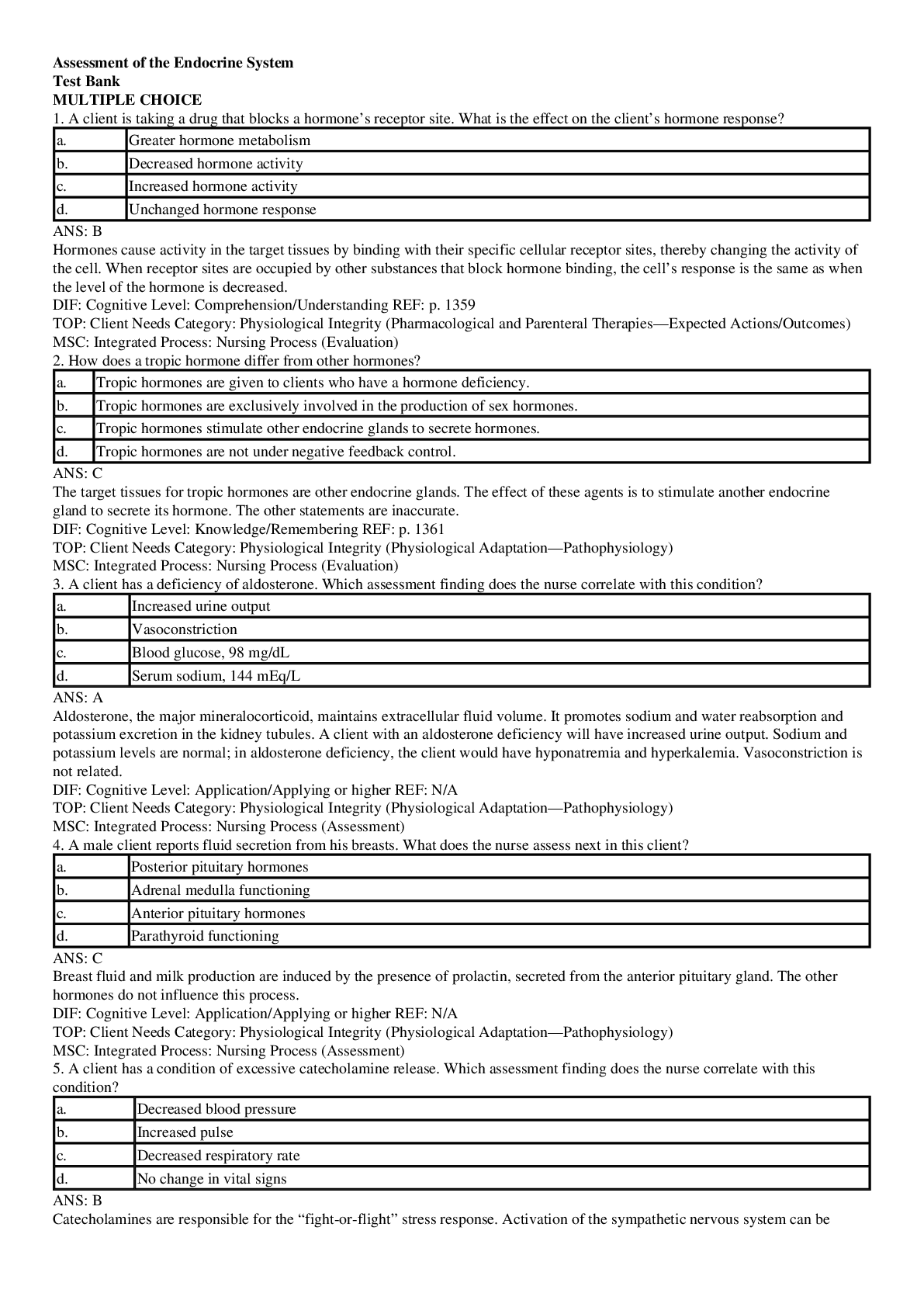

.png)
.png)
.png)
.png)
.png)

